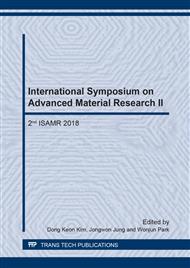p.39
p.45
p.51
p.57
p.64
p.73
p.79
p.85
p.95
Study on Precision Polishing of Alumina Ceramics
Abstract:
The research is mainly to investigate the surface roughness by the mechanical polishing for the processing of alumina ceramic materials. In the experiment, the ceramic test piece was placed between the ceramic work ring and the grinding disc and then grinded firstly with an alumina grinding slurry with a particle size of 10 μm to make the original roughness of the test piece reach Ra value of 1.49 μm. Then the silicon carbide slurry polishing was employed to conduct the experiments by changing the concentration of the polishing, particle size, load, rotation and time to observe the polishing effect of ceramic materials under different parameters. The results showed that the silicon carbide particle size of 2μm, with the polishing time of 50 min, the disc speed of 90 rpm, the concentration of 35%, the original surface roughness of alumina ceramic Ra 1.49μm could be downed to 0.22 μm. The improvement rate could reach 94%. And the greater the specimen load with the better grinding efficiency, the smaller the load caused worse cutting force between alumina and the specimen surface. However, the better the surface roughness when the time kept going. Furthermore, alumina ceramic test piece after precision mechanical polishing by 3D surface roughness profiler and scanning electron microscope (SEM) analysis, the observation found that the wave of the original test piece rugged, after grinding and polishing wave front and grinding scratches had been removed, and a smooth surface was obtained.
Info:
Periodical:
Pages:
64-69
Citation:
Online since:
July 2018
Authors:
Keywords:
Price:
Сopyright:
© 2018 Trans Tech Publications Ltd. All Rights Reserved
Share:
Citation:


